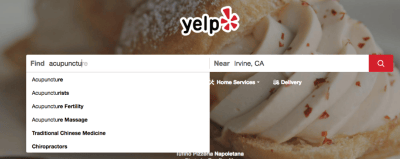More and more people use the internet to find diet and weight loss help. This means if you’re a dietitian or nutritionist, you need to be easy to find online. If people can’t find you on the internet, they will find someone else.
Google Ads is a platform that helps you be seen at the top of Google’s search results. Read on to continue learning Google Ads for Dietitians and Nutritionists.
Table of Contents
ToggleWhat is Google Ads?
Google Ads is about using Google’s advertising platform to connect with potential clients who are actively searching for dietitians and nutritionists services online.
When someone searches on Google, Google shows a list of results. Some of those results are websites that naturally appear because Google thinks they’re helpful, that’s called ‘organic search’. Google Ads, on the other hand, lets you pay to have your information shown right at the top of that list. So, instead of waiting for people to find you through regular search results, you’re actively showing up when they’re specifically searching for what you offer.
In Google Ads, you create ads that highlight your expertise. When people see your ad, they click on it and learn about your services. This helps you reach people who are looking for your help, and it makes it easier for them to become your clients.
Google Ads enables you to target your ads to specific audiences based on location, keywords, and demographic. This amazing platform helps you stand out from the crowd and increase your visibility.
Are you ready to start your Google Ads for Dietitians and Nutritionists journey?
Let’s begin.
Setting Up a Successful Google Ads Campaign
Before you can use Google Ads, you’ll need a Google account to manage everything. If you have been using Gmail, Google Drive, or any other Google services, you’re all set! Just use that existing account. But, if you don’t have one yet, go to accounts.google.com and follow the simple steps to create a brand-new account. This will act as your key to accessing and managing your Google Ads.
Once your Google account is ready, it’s time to enter the Google Ads platform. Fire up your preferred web browser and type in ads.google.com. You’ll be greeted by the Google Ads homepage, where you’ll find a prominent ‘Start now’ button. Click on this to begin the journey of setting up your advertising campaigns.
Campaign Objective
You need to first choose your campaign objective. There are a few options. This allows you to instruct your Google Ads for Dietitians and Nutritionists on what to do for this certain campaign. You can increase your website traffic, or you can also convert your online visitors to clients by choosing Leads.
Leads allow for personalized follow-up, which is important in the healthcare and wellness industry. Dietitians and nutritionists can use the information gathered to tailor your communication and address the specific needs of each potential client.
Select Leads as your initial campaign goal.
Campaign Type
You can now choose the campaign type of your Google Ads for Dietitians and Nutritionists. Search campaigns allow for highly targeted advertising based on keywords. This means you can set your ads to specific dietary needs, such as diabetes management, sports nutrition, or pediatric nutrition.
Choose Search as your campaign type.
Business Information
This step is about providing Google with the necessary context to help you create a more effective and targeted Google Ads campaign. The more accurate and detailed your information, the better Google can assist you in reaching your ideal clients.
Campaign Name
Name your campaign. It is much easier to manage if campaigns are broken down by service. Different services attract different audiences. Creating separate campaigns for each service allows you to maintain a highly organized and efficient Google Ads structure.
Want to grow your practice with Google Ads? We’ll help you reach people searching for your expertise.
Bidding Strategy
Starting a Google Ads campaign means you’ll be short on information about how well your ads lead to conversions, like people filling out forms or scheduling appointments. ‘Maximize clicks‘ lets you gather the data you need to see what keywords, ad text, and website pages are working.
Network Setting
Network means where your ads show up. You have three choices:
- Google Search — This puts your ads on the pages where people type things into Google to look for answers or solutions.
- Search Partners — This puts your ads on other search websites that work with Google.
- Display Network — This puts your ads on regular websites, apps, and videos.
For the services you offer, it’s usually best to only use Google Search at first. This is because you want to show your ads to people who are surely looking for help with their diet. If you use the other choices, your ads might show up to people who aren’t interested, which wastes your money. Google Search is the best place to find people who are actively searching for dietitians and nutritionists.
Turn off both Google Search Partners Network and Google Display Network.
Locations
If you have a physical office, you should tell Google to show your ads to people in your town or nearby areas. This makes sure people who can actually come see you will see your ads. If you give advice online, you can show your ads to people in bigger areas, like whole states or countries. 
Exclude
You can tell Google in this option, “Don’t show my ads in these towns”. This helps you save money because you’re not showing ads to people who aren’t your customers. It also makes your ads more helpful to the right people, because they only see them when it makes sense. Plus, it keeps your ads away from places that could make your business look bad. Basically, “exclude” is like being picky about where your ads go, so you get the best results.
Basically, when you tell Google Ads to target ‘Presence: People in or regularly in your included locations’, you’re making sure your ads only show to people who live nearby or spend a lot of time in your area. This is really important if you have an office where people come to see you. It stops your ads from showing to people who are just visiting or live far away, which would be a waste of money. Instead, you’re only paying to reach people who could actually become your customers, making your ads work better.
Languages
The ‘languages’ setting in Google Ads like choosing which languages your ads will speak. If you only talk to people in English, you just pick English. This way, your ads only pop up when someone searches in English. But, if you help people who speak other languages too, like Spanish, you need to add those languages. This means your ads will show up when people search using Spanish words. This makes sure you talk to everyone who might need your help, and you don’t waste ads on people who won’t understand them.
Audience Segments
Audience segments allow dietitians and nutritionists to target specific groups of people based on their interests, habits, and demographics. Imagine grouping people who are already interested in healthy eating or those who have shown they’re actively looking for weight loss solutions. By using audience segments, you can show your ads to those individuals.
For example, you might target people who frequently search for fitness-related content, or those who have visited websites about healthy recipes. This focused approach helps to ensure that your advertising reaches individuals who are genuinely interested in nutrition and dietary guidance, leading to more efficient use of your advertising budget and a higher chance of connecting with your potential clients.
Target Service Breakdown
This targeted service breakdown donut chart below offers significant clarity and benefits for dietitians and nutritionists in several ways:
It provides a clear visual representation of the relative demand for different nutrition services. This allows you to quickly understand which services are most sought after by potential clients. By highlighting the most popular services, this chart helps you identify areas where you can expand your practice or focus your marketing efforts.
It helps you understand who you are trying to reach.
In essence, this donut chart serves as a valuable tool for dietitians and nutritionists like you to gain a data-driven understanding of your market, optimize your marketing efforts, and ultimately grow your practice.
Considerations:
- These are estimates, not precise figures.
- Local Search trends will vary.
- It is very important to conduct keyword research using tools such as Google Keyword Planner, to get accurate data.
Struggling to reach health-conscious clients online? Our Google Ads experts understand your needs. Let us show you how to get more leads now.
Campaign Duration
Campaign Duration refers to the timeframe your advertisements will run. You can choose to have your campaign run continuously, or set specific start and end dates. For your Google Ads for dietitians and nutritionists, a continuously running campaign is often the most effective approach. This allows for consistent visibility and lead generation, rather than relying on short bursts of advertising.
Since dietary needs and health goals are ongoing for many people, having constant online presence ensures that potential clients can find your services whenever they’re needed. While specific promotions or seasonal programs might warrant setting start and end dates, maintaining a consistent campaign helps build a steady flow of clients and strengthens your online presence over time.
Ad Schedule
Ad schedule allows you to control the days and times your advertisements are shown. This is useful for you if you want to reach potential clients during specific hours. For example, if you know most appointment bookings occur during weekdays in the afternoon, you can set your ads to run primarily during those times.
This ensures that your ads are displayed when people are most likely to engage with them. Additionally, if you offer after-work or weekend appointments, you can adjust your ad schedule to reflect those availability times. This avoids showing ads when your services are unavailable.
Keyword Research and Ad Group Creation
Keywords
Choosing the right keywords is very important for your Google Ads for dietitians and nutritionists. If someone searches for ‘weight loss help near me’, you want your ad to show up. So, you’d use keywords like ‘weight loss dietitian’ or ‘nutritionist for weight management’.
It’s also important to think about different types of keywords. Some might be very specific, like ‘diabetes meal planning [city]’, while others might be more general, like ‘healthy eating advice’.
Keywords is using the same words in your ads that people use when they’re looking for help with their diet. This way, when someone types those words into Google, your ad will show up.
Keyword Planner
The Keyword Planner is like a helper tool inside Google Ads. It shows you what words people use when they search for things like ‘nutritionist near me’. You type in some words you think people might use, and it tells you which ones are popular and how much they cost. This helps you pick the right words for your ads so you find the right clients.

Negative Keywords
Negative keywords are words you tell Google to ignore. It’s like saying, ‘Don’t show my ad if these words are in the search.’ This stops your ads from showing up when people search for things you don’t provide, like free or cheap services. It helps your ads find the right customers.
More examples for your Google Ads for dietitians and nutritionists:
- If you are a local dietitian focusing on one-on-one consultations, you would want to add negative keywords like ‘online courses’, ‘free recipes’, and the names of cities outside your service area.
- If you specialize in adult nutrition, you’d add ‘baby food’ and ‘pediatric’ as negative keywords.
- If you provide meal plans and consultations but don’t sell supplements, you would add ‘supplements’ and ‘nutritional products’.

Ad Groups
Ad groups are like folders for your ads and keywords. You make different folders for each service you offer, like weight loss or diabetes plans. This keeps things organized and shows people ads that match exactly what they’re looking for.
Final URL
The Final URL is the ‘destination address’ . It is the precise web location where users are taken after they select your advertisement. For a dietitian, this might be a specific service page like ‘weightlossprogram.com‘ or a booking page.
Display Path
The Display Path is a simplified version of the URL shown in your ad, like ‘YourWebsite.com/WeightLoss‘. It’s designed to be user-friendly and give people an idea of where they’ll end up. For instance, if your final URL is a long, complex address, the display path can be a shorter, clearer version that still tells potential clients what to expect.
Headlines
Headlines are the ‘introductory phrases’ of your ad. These are the first pieces of text viewers encounter in your online advertisements.
Use keywords that people are likely to search for, such as ‘Weight Loss Nutritionist’, or ‘Diabetes Meal Plans’. Emphasize your expertise and the results clients can expect, for example, ‘Achieve Your Health Goals’, or ‘Expert Dietary Guidance’.
Descriptions
Descriptions tell people more about what you do as a dietitian or nutritionist. It’s like a short explanation that helps them decide to click on your ad.

Sitelinks
Sitelinks are the ‘additional navigation options’ of your ad. For your Google Ads for dietitians and nutritionists, this could include links to service pages, such as ‘Weight Loss Programs’, ‘Diabetes Management’, or ‘Meet Our Team’.
Sitelinks improve the user experience by providing quick access to relevant content and can also increase the size of your ad, making it more visible.
Callouts
Callouts are the ‘feature points’ of your campaign. They provide extra information and help your ad stand out. This could include phrases like ‘Personalized Meal Plans’, ‘Expert Nutritional Guidance’, ‘Certified Professionals’, or ‘Local Support’.
Callouts emphasize your strengths and help potential clients understand the value you offer, without taking up valuable space in your headline or description.
Landing Page
A Landing Page is not your whole website, just a single page made for one purpose — getting people to make an appointment.
Your landing page must contain these following key parts in order to convert visitors to clients:
-
Headlines are the first things people read. They need to be short, easy to understand, and make people want to learn more.
Examples:
- “Achieve Sustainable Weight Loss with Personalized Plans”
- “Control Your Diabetes with Expert Nutritional Guidance.”
- Hero Image is the main picture your online visitors see first. It should be a good image that matches what you do and what your clients want. Images of healthy food, active individuals, or happy clients can be effective.
-
CTA (Call to Action) is the button that tells people what to do next.
Examples:
- “Book a Free Consultation”
- “Download Your Meal Plan”
- “Schedule an Appointment”
-
Key Benefits clearly explain the advantages of choosing your services. Focus on how you can solve your clients’ problems and improve their lives.
Examples:
- “Personalized meal plans tailored to your unique needs”
- “Expert guidance from a certified dietitian”
- “Sustainable results you can maintain”
-
Unique Selling Proposition (USP) is what sets you apart from other dietitians and nutritionists. It’s your unique value proposition.
Examples:
- “Specializing in gut health and digestive disorders
- “Combining traditional nutrition with functional medicine”
- “Offering a personalized, holistic approach to wellness”
- Address Users’ Concerns anticipate and address common concerns or objections that potential clients may have. This could include addressing concerns about cost, time commitment, or the effectiveness of your programs.
- Short Lead Form asks for essential information like name, email address, and phone number. Keep the form concise to minimize friction.
- Testimonials shows people you’re reliable by using good reviews from happy customers. Share their stories and pictures. Social proof demonstrates that your services are effective and can help potential clients feel more confident in their decision.
Landing Page Sample:






Budget
If you’re a beginner and want a quick start, Google’s suggestions for setting your budget campaign can be helpful, but monitor closely. If you want maximum control and budget management, a custom budget is the way to go.
Always monitor and adjust your budget based on your campaign’s performance.
Ready to fill your client schedule? We create Google Ads plans just for you. Start attracting more clients today.
Launching the Campaign
It’s really important to double-check everything. Look closely at all your settings, like where your ads will show and who will see them. Once you’re sure everything is correct, and you’re happy with how it all looks, it’s time to make your ads start showing.
To do this, just click the button that says Publish campaign.
That’s it! Your ads are now out there, and people can start seeing them.
Monitor Your Ad Performance
After your ads start, watch them closely. See what’s working and what’s not. Change things that aren’t working well. Google Ads gives you numbers to help you do this.
Wrap Up
Let’s bring it all together and show you why Google Ads is a game-changer for dietitians and nutritionists. We’ve gone over the key steps: finding the right keywords, targeting the right people, writing ads that grab attention, and creating landing pages that turn visitors into clients.
By using the Keyword Planner, you can find the exact words people type when they’re looking for help with their diet. Targeting audience segments lets you show your ads to people already interested in healthy living. And with strong ad headlines and descriptions, you can tell potential clients how you can help them achieve their health goals.
Want to see real growth in your nutrition practice? We deliver. Our agency can handle your Google Ads for dietitians and nutritionists, proven by thousands of successful campaigns. Get insights from our past work at YoYoFuMedia’s Case Studies Page. We’ll pinpoint the keywords that drive traffic, write ads that convert, and optimize your landing pages for maximum impact. If you’re serious about expanding your client base and reaching more people, we’re the team to make it happen.








